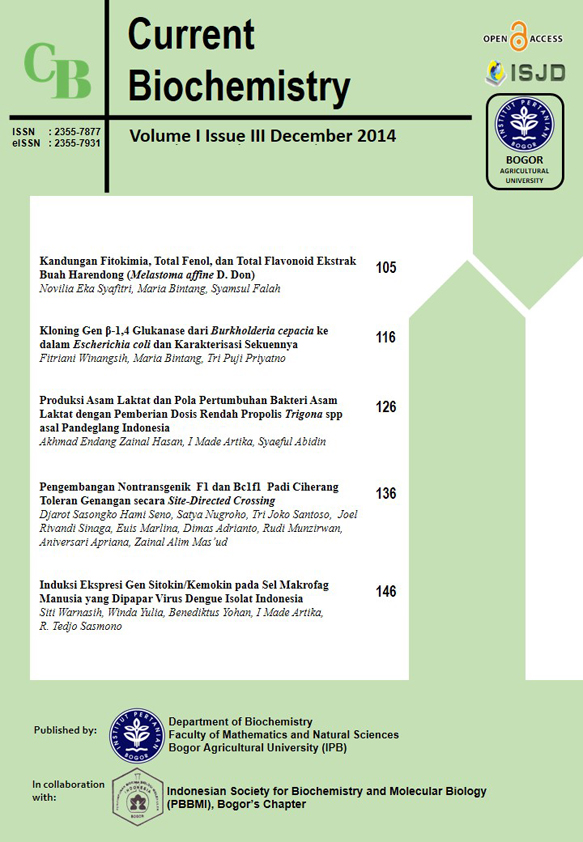Pengembangan Nontransgenik F1 dan Bc1f1 Padi Ciherang Toleran Genangan secara <i>Site-Directed Crossing</i>
Abstract
The development of submergence tolerant rice varieties is urgently required to maintain the stability of future food production, to anticipate the unpredictable global climate changes. Due to in-economical agronomic traits of native submergence tolerant varieties for large scale cultivation, submergence tolerance gene (sub1) must be introduced into popular high-yielding rice variety, such as Ciherang. To develop new submergence tolerant variety with good agronomic traits as those of Ciherang, in this research, submergence tolerance gene (sub1) was introduced into Ciherang variety. To avoid strict GMO regulation, gene introduction was carried out through site-directed crossing. Donor sub1 was crossed with Ciherang host. The selected F1 progenies were further backcrossed to Ciherang 4 x to obtain BC5F1 progeny having ~98% agronomic traits of those of Ciherang. In every cross/backcross generation, submergence test was performed, followed by sub1 marker-assisted PCR. F1 and BC1F1 submergence-tolerant Ciherang were successfully constructed. Co-dominant RM464A marker was not able to discriminate between host, donor, and progenies (F1 and BC1). Co-dominant RM219 maker showed slightly different size between donor and host amplicon, but it was difficult to see their heterozygous progenies. Both C173 and AEX1 dominant markers were able to show sub1 introgression from donor to host. PCR results confirmed that progenies-submergence tolerance was due to sub1 introgression, not escape mechanisms. AEX1 was chosen for subsequent experiments. Backcross until BC5 is in progress, to obtain maximum host retention for engineering new submergence tolerant varieties with good agronomic traits as those of Ciherang.
References
ACPFG (Australian Centre for Plant Functional Genomics). 2008. Annual report. Australian Centre for Plant Functional Genomics Pty. Ltd., pp: 15-17; 23-25.
Bradbury LM, Fitgerald TL, Henry RJ, Jin Q, Waters DLE. 2005a. The gene for fragrance in rice. Plant Biotech J 3:363–370.
Bradbury LMT, Henry RJ, Jin Q, Reinke RF, Waters DLE. 2005b. A perfect marker for fragrance genotyping in rice. Mol Breed 16:279–283.
Ella ES, Kawano N, Yamauchi Y, Tanaka K, Ismail AM. 2000. Blocking ethylene perception enhances flooding tolerance of rice. Indian J. Plant Physiol. 30: 813-819.
Fukao T, Serres J. 2008. Submergence tolerance conferred by Sub1Ais mediated by SLR1 and SLRL1 restriction of gibberellin responses in rice. PNAS. 105: 16814-19
Gong Z, Chinnusamy V, Zhu J-K. 2008. The Molecular networks of abiotic stress signallng, Ann. Plant Rev.33: 388-416
Herdt RW. 1991. Research priorities for rice biotechnology, dalam Khus GS dan Toenniessen GH (ed), Rice Biotechnology, IRRI, CAB International, Wallingford, UK
Jackson MB dan Ram PC (2003) Physiological and molecular basis of susceptibility and tolerance of rice plants to complete submergence. Ann. Bot.91: 227-41.
Jackson MB, Waters L, Setter TL, Greenway H (1987) Injury to rice plants caused by complete submergence: a contribution by
ethylene (ethene). J. Exp. Bot.38: 1826-38.
Lang NT dan Bu BC (2008) Development of PCR-based markers for aroma (fgr) gene in rice (Oryza sativaI L.). Omonrice 16: 16-23.
Lu J J. and Chang T T. 1980. Rice in Temporal and Spatial Prospective. In Rice Production and Utilization. Bor s. Luh (ed). West Port: AVI Pb.
Mackill DJ, Septiningsih E, Pamploma AM, Sanches D, Iftekhar A, Masudussaman AS, Collard B, Neeraja C, Vergara G, Maghirang Rodriquez, R, Heuer S, Ismail AM (2007) Marker assisted selection for submergence tolerance in rice. Mol. Plant Breeding 5:207-208.
Mohanty HK, Mallik S, Grover A (2000) Prospect of improving flooding tolerance in lowland rice varieties by conventional breeding and genetic engineering. Curr. Sci.78: 132-140.
Perata P, Voesenek LACJ (2006) Submergence tolerance in rice requires Sub1A, an ethyleneresponse-factor-like gene. Trends in Plant Sci. 12: 43-46.
Redona ED, Mackill DJ (1996) Mapping quantitative trait loci for seedling vigor in rice using RFLPs. Theor. Appl. Genet.92: 395-402.
Sambrook J, Fritsch EF, Maniatis T (1989) Molecular Cloning. A Laboratory Manual. 2nd ed., Books:1-3, Cold Spring Harbor Laboratory Press, USA.
Sarkar RK, Reddy JN, Sharma SG, Ismail AM (2006) Physiology basis of submergence in rice and implications for crop protection. Curr. Sci.91: 899-906.
Sakthivel K, Rani NS, Pandey MK, Sivaranjani AKP, Neeraja CN, Balachandran SM, Madhav MS, Viraktamath BC, Prasad SV, and Sundaram RM (2009) Development of a simple functional marker for fragrance in rice and its validation in Indian Basmati and non-Basmati fragrant rice varieties. Mol. Breeding DOI 10.1007/s11032-009-9283-x
Septiningsih EM, Alvaro M. Pamplona, Darlene L. Sanchez, Chirravuri N. Neeraja, Georgina V. Vergara, Sigrid Heuer, Abdelbagi M. Ismail and David J. Mackill. 2009. Development of submergence-tolerant rice cultivars: the Sub1 locus dan beyond. Annals of Botany 103:151-160.
Shi W, Yang Y, Chen S, Xu M (2008) Discovery of a new fragrance allele and the development of functional markers for the breeding of fragrant rice varieties. Mol. Breeding 22: 185-192.
Sub1 Rice News (2007) IRRI-Japan project on submergence-tolerant rice varieties. Vol 1 October-December.
Thach TD (1999) A deepwater tolerant gene detected in the common wild rice. Omonrice. 7: 174-6.
Xiao B, Huang Y, Tang N, Xiong L (2007) Overexpression of a LEA gene in rice improves drought resistance under the field conditions, Theor. Appl. Genet. 115: 35–46.
Xu K, Deb R, Mackill DJ (2004) A microsatellite Marker and a Codominant PCR-Based Marker for Marker-assistedselection of Submergence Tolerance in Rice. Crop Sci. 44:248–253.
Zheng X, Chen B, Lu G, Han B (2009) Overexpression of a NAC transcription factor enhances rice drought and salt tolerance. Biochem. Biophys. Res. Commun. 379: 985–989.













